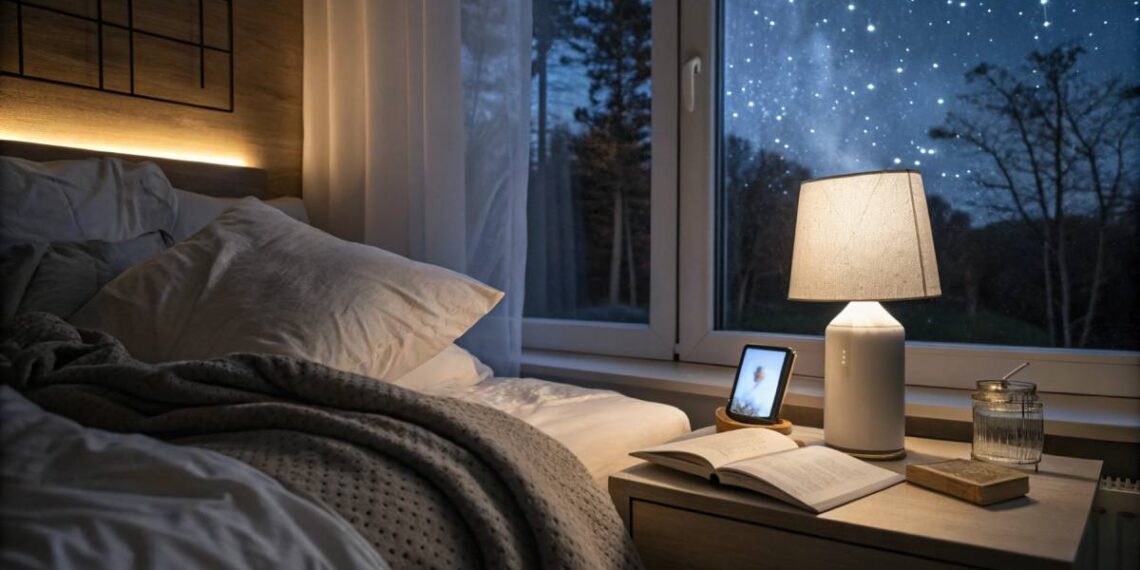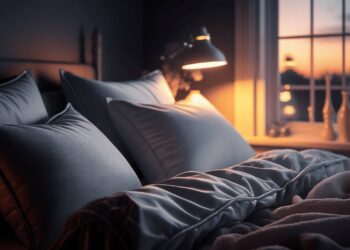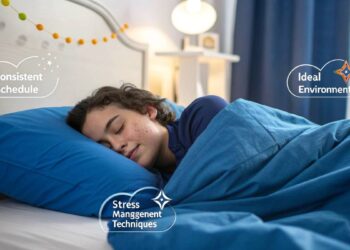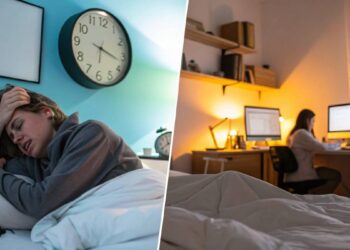In our hyper-connected world, the glow of screens often steals away our precious sleep. Ever found yourself scrolling endlessly before bedtime, only to lie awake staring at the ceiling? You’re not alone. Discovering effective digital detox strategies can transform your nightly routine, harmonize your circadian rhythms, and grant you the restful sleep you deserve. Dive into our comprehensive guide to create a sleep-friendly sanctuary, free from the clutches of technology, and embrace nights filled with serene slumber.
Key Takeaways
- Digital Detox Improves Sleep Quality: Reducing screen time before bed enhances melatonin production, facilitating easier and more restful sleep.
- Establishing Tech-Free Zones: Designating specific areas, especially the bedroom, as gadget-free promotes a peaceful sleep environment.
- Incorporating Relaxation Techniques: Practices like mindfulness meditation, deep breathing, and progressive muscle relaxation significantly improve sleep readiness.
- Consistent Pre-Sleep Routines: Maintaining a steady nightly routine signals the body to wind down, leading to better sleep patterns.
- Monitoring and Adjusting: Tracking sleep progress and making necessary adjustments ensures the effectiveness of digital detox strategies.
The Importance of Quality Sleep
Ah, sleep—turns out, it’s kinda important for, well, just about everything. From keeping the brain’s gears greased to making sure you’re not grouchy as a bear, sleep’s got your back. But nowadays, with our screens glued to our faces, it’s worth having a yak about how these gadgets mess with our shut-eye.
Understanding the Impact of Digital Devices on Sleep
Let’s chat about the gizmos—smartphones, tablets, and laptops. They’re like your shadow—always there—but when it comes to bedtime, they start causing trouble. Their screens throw out blue light, which mucks up the production of melatonin—the stuff that tells your brain, “Hey, it’s pillow time!” This means you could lay there, eyes wide open, counting sheep that ain’t coming.
| Digital Device | Average Blue Light Emission (lux) |
|---|---|
| Smartphone | 30-50 |
| Tablet | 15-30 |
| Laptop | 10-25 |
| Television | 2-10 |
If you’re glued to these gadgets, you’ll find yourself tossing and turning, waking up at the drop of a hat, and clocking less snooze time than needed. Chronic insomnia pals—or if you’re just a wreck without sleep—this device madness is not your friend.
Wanna fix your sleep schedule? Check out our guide on resetting your sleep cycle.
Introducing the Concept of Digital Detox for Better Sleep
Time for a screen break, folks! Shed the pixels and try a digital detox to give your sleep a fighting chance. Ditching devices, especially before hitting the hay, lessens the havoc of blue light and stops the brain from turning into a carnival when it should be chilling out.
Here’s what ditching your tech before bed can do:
- Improved Sleep Quality: Less blue light means melatonin can do its job, helping you fall into a natural rhythm.
- Enhanced Sleep Duration: Cut down on the screen binge and you’ll be less likely to delay hitting the sack, netting you more Zs.
- Circadian Rhythm Boost: Let your body’s internal clock tick and tock nicely without digital interruption, making wake-up time less of a bear.
Curious about other natural ways to catch some Zs? Take a gander at our piece on natural sleep solutions.
Pairing a digital detox with other back-to-nature sleep aids like herbal teas for sleep or essential oils for sleep can make all the difference. These tried-and-true strategies might just turn your restless nights into a haven of sweet slumber, helping you dodge the nasty loop of digital-upset sleep.
Benefits of Digital Detox for Sleep
Ditching screens before bed can work wonders for your sleep. It’s like trading a chaotic circus for a peaceful meadow. Let’s dive into how it helps you catch those elusive Z’s by improving sleep quality, stretching sleep time, and syncing up your body’s internal clock.
Improved Sleep Quality
Ever feel like a zombie after a night with your phone? That’s the sneaky blue light tricking your brain. It stops melatonin, the sleep hormone, from doing its job. Swapping screen time for some good old-fashioned relaxation means more melatonin, better shuteye, and feeling like a human again.
Sleep Quality Transformation with Digital Detox
| Indicator | Pre-Detox | Post-Detox |
|---|---|---|
| Time to Fall Asleep (minutes) | 30-45 | 10-20 |
| Times You Wake Up (per night) | 3-4 | 1-2 |
| Sleep Efficiency (%) | 70-75 | 85-90 |
Enhanced Sleep Duration
Scrolling or sleeping? Choose wisely. Dump the digital distractions and trade in social media surfing for actual rest. More hours under the sheets equals better mood, sharper mind, and a happier you.
Sleep Length Gains After Digital Detox
| Indicator | Pre-Detox | Post-Detox |
|---|---|---|
| Total Z’s (hours) | 6-7 | 7-8 |
| Deep Sleep (hours) | 1-1.5 | 1.5-2 |
| Dream Time (REM, hours) | 1.5-2 | 2-2.5 |
Regulation of Circadian Rhythms
Your body’s clock is a picky beast. Messing with screens mucks it up, leaving you wide-eyed at 3 a.m. Bid farewell to tech late at night, embrace consistency, and wake up feeling fresher than a morning breeze.
Before vs After: Circadian Clock Reset
| Indicator | Pre-Detox | Post-Detox |
|---|---|---|
| Bedtime Consistency | All Over the Place | Like Clockwork |
| Sleep-Wake Regularity | Jumbled | Smooth sailing |
| Morning Alertness | Snooze Button Dependent | Up and At ‘Em! |
Bringing tech detox into your nightly ritual can do wonders for how you sleep. Check out our other reads about snoozing the natural way, like natural sleep solutions, how to fall asleep naturally, and best natural sleep aids. Sweet dreams!
Strategies for Digital Detox
Alright, folks, we’re diving into digital detox! It’s sorta like taking a breather from the nonstop screen glow to catch some Zs. Here’s how you can hit refresh and boost sleep without your gadgets running the show.
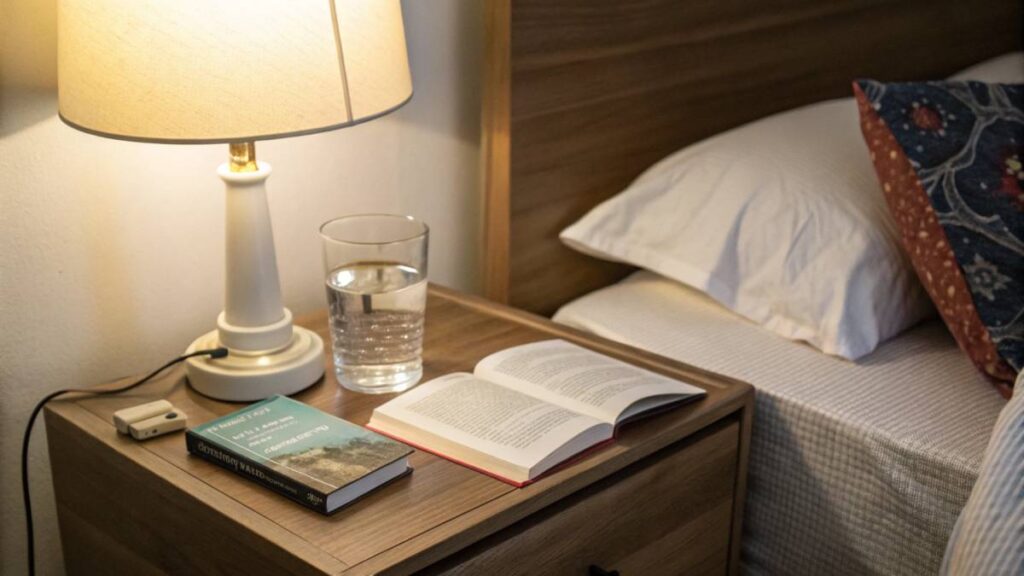
Setting Boundaries with Technology
Let’s face it, our gadgets have a knack for keeping us glued at just the wrong times. To dodge that, think about setting some solid tech rules. Here’s how:
- Put Screens to Bed Early: Have your screens off-duty at least an hour before you hit the hay. Your mind will thank you.
- Limit Daily Screen Staring: Set boundaries on screen time so your brain isn’t bouncing off digital walls all day.
- Chill Breaks: Sneak in screen breaks between screen-binge sessions. Help those eyes—and yourself—stay chill.
“Almost everything will work again if you unplug it for a few minutes, including you.” – Anne Lamott
These little shifts make it easier to slip into snooze mode. Want more natural sleep hacks? Check out our piece on falling asleep naturally.
Creating a Pre-Sleep Routine
Getting your body the memo that it’s time to wind down can be a game changer. A few hints include:
- Grab a Paperback: Pop open a book, or grab a simple Kindle.
- Zen Out with Meditation: Clear that crowded mind with calming breaths. Peek at our guide on meditation for sleep.
- Soak it Up: A warm bath? Pure bliss for tired muscles and minds.
Keeping a steady nightly groove ushers in deeper, peaceful zzz’s. Fancy more bedtime routine ideas? Visit our piece on bedtime routines for adults.
Designating Tech-Free Zones
Now, here’s where it gets serious—make certain spots in your home gadget-free. Think about these places:
- The Bedroom: Make it all about snoozing—ditch those electronics. No TVs, no phones.
- Mealtime Matters: Nourish yourself, not your social feeds. Keep tech out of your dining area and savor the calm.
These zones work like magic, crafting a quiet retreat ready for rest. Curious about building a sleep haven? Check our tips on a sleep-friendly bedroom.
Embracing these digital detox strategies can do wonders for sleep, smoothing out circadian rhythms, and getting you the dreamiest rest ever known as digital detox sleep pluses. Sweet dreams!
Incorporating Relaxation Techniques
Sprinkling some relaxation techniques into your nightly routine can work wonders for your snooze time, and it might even help you enjoy those unplugged nights without all the screen glare. Let’s look at some ways to get all tuckered out and ready for dreamland.
“Meditation is not a way of making your mind quiet. It is a way of entering into the quiet that’s already there.” – Deepak Chopra
Mindfulness Meditation
Mindfulness meditation is all about keeping your mind right here, right now, without giving yourself a hard time. It’s a great way to sweep stress and jitters out the door, letting your brain chill before bedtime.
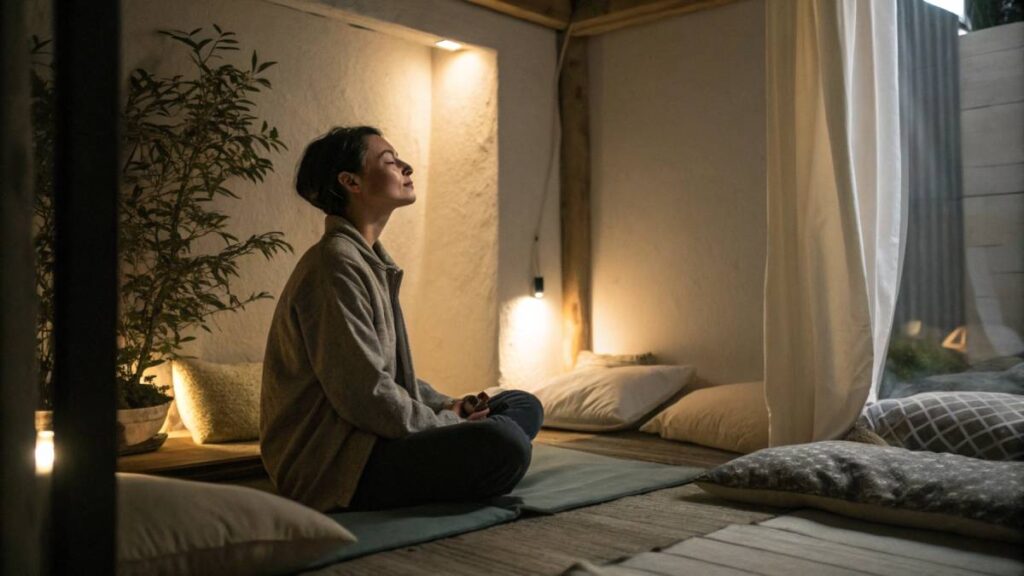
Here’s a quick how-to:
- Find a cozy nook to sit or sprawl out.
- Close those peepers and breathe nice and slow.
- Zero in on each breath, feeling every in and out.
- If your mind decides to wander, gently bring it back to your breathing.
Want to take a deeper dive into meditation? Check out our meditation for sleep guide!
Deep Breathing Exercises
Deep breathing exercises are like a magic trick to settle your body and mind. Breathe deeply and slowly—it’s simple, and it’s got some serious calming power.
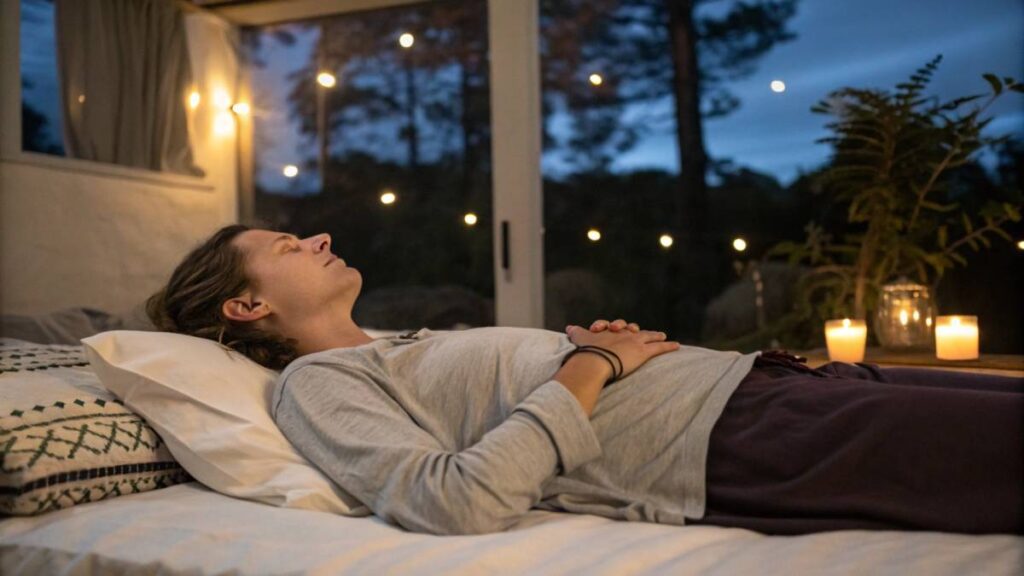
Here’s the drill:
- Take a seat or lay down comfortably.
- Breathe in through your nose, counting to four.
- Keep that breath in for a count of seven.
- Let it out slowly through your mouth for a count of eight.
- Run through this cycle 4-6 times.
Add deep breathing to your bedtime routine for adults for an easy wind-down session.
Progressive Muscle Relaxation
Progressive muscle relaxation (PMR) is like a massage you don’t have to pay for. You tighten and then release muscles from your toes to your noggin, easing tension and inviting sleep.

Give PMR a try:
- Get comfy on your back or side.
- Start with your toes, clenching them for a few seconds, then ease up for a few more.
- Work your way up, tensing and then relaxing each muscle group.
- Remember to keep your breaths steady throughout.
Pair PMR with deep breathing exercises, and you’ll have a bedtime routine smoother than a lullaby.
Mixing these relaxation techniques into your pre-sleep routine will help create moments of peace and quiet—perfect when you’re stepping away from tech toys. For more insights on natural sleep hacks, check out our articles on stress and sleep solutions and how to fall asleep naturally. Whether you’re into meditation, a breathing rookie, or a PMR pro, we’ve got the goods to guide you to a better night’s sleep.
Creating a Chill Sleep Zone
Getting the most outta a digital detox means making a space that whispers, “Snooze time!” Let’s chat about setting up your sleep cave right, cranking the temp just so, and starting a little bedtime dance.
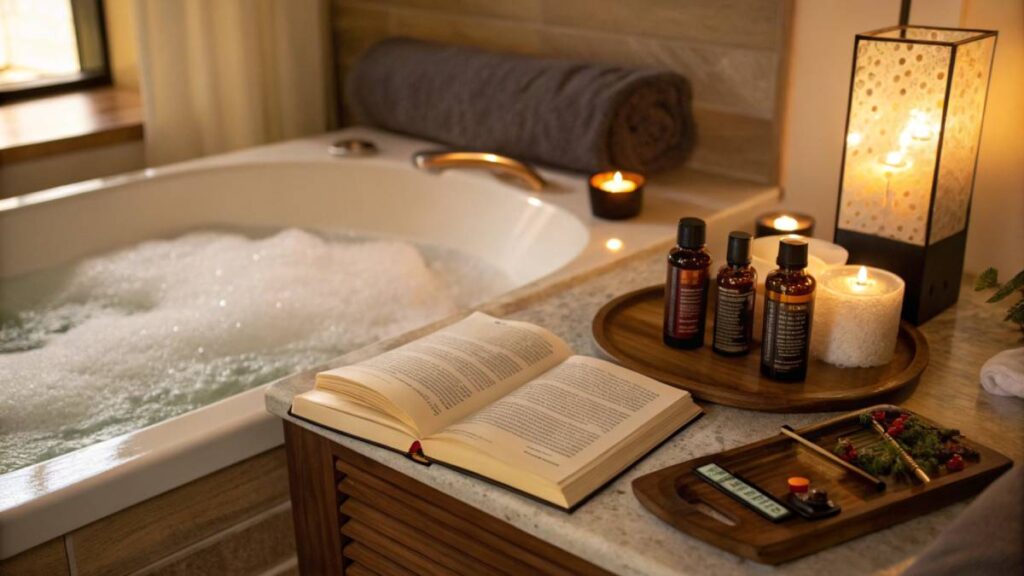
Bedroom Vibes
A room that’s neat and comfy can work wonders on sleep. Think about light bulbs, sound, and choosing the right squishy platform (yep, your bed!). A mess-free zone tells your brain it’s time to shut down.
| Thing | Helpful Hint |
|---|---|
| Lighting | Go for soft or dim lights as the day winds down |
| Noise | Try white noise or earplugs to hush the outside world |
| Mattress | Pick a mattress that feels just right for you |
| Bedding | Find cozy, breathable sheets and blankets |
Want more ideas? Look into creating a chill sleep spot.
Nailing the Room Temperature
The right temp can spell the difference between peaceful slumber and a whole lotta tossing and turning. A cool room often equals faster drift-off and fewer wake-ups.
| Temp Range (°F) | Sleep Score |
|---|---|
| 60 – 67 | The sweet spot for many |
| Below 60 | Brrr! Cold feet alert |
| Above 67 | Might get you sweating and squirmy |
Setting the perfect temp is like giving your sleep a comfy hug.
Bedtime Routines Rock
Doing the same stuff before bed tells your body, “Hey, it’s lights-out time!” Routines can straighten out sleep cycles and layer on the Z’s.
Think about adding these chill moves to your night:
- Flipping pages of a good book
- Enjoying a warm bath
- Trying some nighttime meditation
- Putting a dab of sleepy-time oils
These habits can smooth the ride from buzzing to snoozing. For more grown-up bedtime tips, check out nighttime rituals for adults.
Making your space snooze-friendly through clever room setups, perfect temps, and chill routines really bumps up those digital detox sleep perks. If you’re searching for all-natural sleep tricks, give these a whirl to catch more zzz’s.
Tracking Progress and Adjustments
Keeping an eye on your digital detox journey is essential to fully enjoy those sweet sleep benefits. Knowing where you stand and tweaking things as needed can make a world of difference when you’re aiming to sleep better.
Monitoring Sleep Patterns
Jotting down how you sleep isn’t just for kicks; it’s like a mini-spotlight on how your unplugged time is paying off. A good number of folks use sleep journals or those nifty sleep apps to check on their z’s — stuff like how long they sleep and how fresh they feel when they wake up.
| Measure | Before Detox | After Detox Week 1 | After Detox Week 2 |
|---|---|---|---|
| Average Sleep Duration (hours) | 5.5 | 6.2 | 7.0 |
| Number of Night Awakenings | 3 | 2 | 1 |
| Sleep Quality Rating (1-10) | 4 | 6 | 8 |
Keeping a log like this lets you see the big picture and decide what needs tweaking on your digital detox plan.
Making Necessary Adjustments
So, what if your shuteye isn’t as great as you’d hoped? Time to switch things up based on your sleep log. Maybe try out:
- Rethinking your pre-sleep groove.
- Looking at ways to chill out if you’re stressing before bed, like checking out how to manage sleep anxiety.
- Giving meditation for sleep a shot, or any chill-out techniques you haven’t tried yet.
Tiny tweaks can really shake up the way you sleep and boost your well-being more than you’d think.
Celebrating Successes
Give yourself a high five when you hit those digital detox goals! It can keep the pep in your step. Here’s a way to track your wins:
| Milestone | Achievement Date | Reward |
|---|---|---|
| 1 Week Without Screen Time Before Bed | MM/DD/YYYY | Spa Day |
| Improved Sleep Quality Rate by 2 Points | MM/DD/YYYY | Favorite Meal |
| Consistent 7+ Hours Sleep for a Month | MM/DD/YYYY | Weekend Getaway |
Every time you nail a milestone, it’s proof you’re on the right track, which fuels your fire to keep cutting out that screen time.
Mixing up these strategies of watching, tweaking, and patting yourself on the back can help keep your digital detox on point. And, if you pair these steps with some nifty natural sleep fixes, you could see a real bump in how well you sleep and feel all-around.
Looking for Some Extra Help
So, you’ve decided to cut back on screen time in a bid to snooze better? Good for you! But if you find yourself wanting a bit more help, there’s a whole world of support out there. Think specialists, docs, and even folks just like you—all ready to boost your sleep game.
Get Some Pro Tips on Sleep Habits
Seeing a sleep guru or health pro who knows their zzz’s can give you the inside scoop on making your nighttime rituals more effective. They’ll dish out tips tailored for how you naturally hit the hay. Maybe it’s fine-tuning that pre-bed routine or tackling concerns about catching the night’s winks. Plus, they might suggest trying meditation to relax before bed.
| Who to See | What They Bring to the Table |
|---|---|
| Sleep Guru | Custom tricks for better sleep |
| Health Pro | Tips on sleep, managing stress |
| Therapist | Help with night jitters, emotional support |
Don’t Skip the Doc
If tossing and turning is your nightly jam or insomnia seems to have moved in rent-free, it’s time to see a doc. They can spot any sneaky health issues messing with your snooze and offer the right fix. They’ll chat about safe sleep aids like melatonin or help you find natural takes on sleep apnea.
| Problem | What Might Help |
|---|---|
| Can’t Sleep | Sleep checks, lifestyle tweaks |
| Noisy Breathing | Natural fixes, breathing gadgets |
| Stress-Related Lack of Sleep | Therapy, chill-out methods |
Find Your Crew
Teaming up with others who are also trying to sleep better can keep you going strong. Whether it’s online forums, fun social media chats, or meet-ups in your neighborhood, having a support system means you’ll never face restless nights alone. These spaces cover all sorts of helpful stuff, like foods that help you sleep or exercises to tire you out just right.
| Where to Hang Out | Why It’s Worth It |
|---|---|
| Online Chats | Get advice, share your story |
| Social Media | Find inspiration, handy hints |
| Local Hangouts | Chat face-to-face, join events |
Jumping into these resources will supercharge your digital detox, helping you build a healthier bond with your screens and get that shut-eye you need.
Main Tips
- Establish a Tech Curfew: Turn off all electronic devices at least one hour before bedtime to allow your mind to relax.
- Create a Relaxing Environment: Make your bedroom a sanctuary with comfortable bedding, soft lighting, and minimal clutter.
- Incorporate Relaxation Techniques: Practice mindfulness meditation, deep breathing, or progressive muscle relaxation to prepare your body for sleep.
- Maintain a Consistent Sleep Schedule: Go to bed and wake up at the same time every day to regulate your body’s internal clock.
- Limit Caffeine and Heavy Meals Before Bed: Avoid stimulants and large meals in the evening to prevent sleep disturbances.
Conclusion
Transforming your sleep through a digital detox is not just a trend—it’s a lifestyle change that can profoundly impact your well-being. By setting clear boundaries with technology, creating dedicated tech-free zones, and embracing relaxation techniques, you pave the way for more restful and rejuvenating nights. Consistency is key; establishing a pre-sleep routine helps signal your body that it’s time to wind down, aligning your internal clock for optimal sleep. Moreover, by monitoring your sleep patterns and making informed adjustments, you ensure that your digital detox journey is both effective and sustainable. Remember, the path to better sleep is a marathon, not a sprint. Celebrate your milestones, seek support when needed, and continue striving for that harmonious balance between technology and tranquility. Sweet dreams await those who dare to unplug and prioritize their sleep health.
Frequently Asked Questions
1. What is a digital detox and how does it improve sleep?
A digital detox involves reducing or eliminating screen time, especially before bedtime. It improves sleep by minimizing blue light exposure, which disrupts melatonin production, and by creating a calmer pre-sleep environment.
2. How can I set tech-free zones in my home?
Start by designating the bedroom and dining areas as gadget-free. Replace electronics with relaxing elements like books or plants to encourage a peaceful atmosphere.
3. What relaxation techniques are most effective for better sleep?
Mindfulness meditation, deep breathing exercises, and progressive muscle relaxation are highly effective in calming the mind and preparing the body for restful sleep.
4. How long should I wait after screen time before going to bed?
Aim to turn off all screens at least one hour before bedtime to allow your brain to wind down and melatonin levels to rise naturally.
5. Can digital detox help with chronic insomnia?
Yes, by reducing screen-induced stimulation and promoting better sleep hygiene, a digital detox can alleviate symptoms of chronic insomnia. However, consulting a healthcare professional is recommended for persistent issues.
Resources
- National Sleep Foundation
- Harvard Health on Blue Light and Sleep
- Mindful.org: Meditation for Better Sleep
- American Psychological Association on Sleep Hygiene
- Sleep Cycle App for Monitoring Sleep Patterns
Recommended Products
- Blue Light Blocking Glasses
Protect your eyes from harmful blue light emitted by screens, reducing sleep disruptions. - Essential Oil Diffuser
Enhance your relaxation with soothing scents like lavender and chamomile. - Weighted Blanket
Promote deeper sleep and reduce anxiety with a comfortable weighted blanket. - Sleep Tracker Watch
Monitor your sleep patterns and optimize your digital detox routine. - Menthol-Infused Pillow Spray
Create a calming bedtime atmosphere with a refreshing pillow spray.

